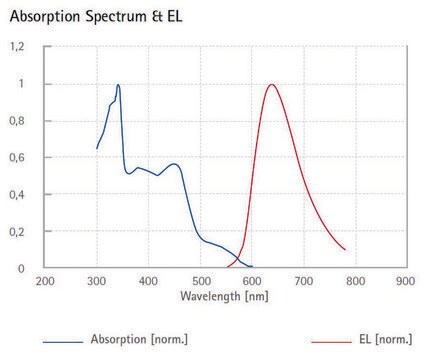900438
Super yellow light-emitting PPV copolymer
Synonym(s):
Livilux®, PDY-132
Sign Into View Organizational & Contract Pricing
All Photos(1)
About This Item
Recommended Products
General description
Super yellow light emitting PPV copolymer can form a thin film of poly(1,4-phenylenevinylene) (PPV) with high efficiencies. It has conjugated polymers as the backbone that can be soluble in water upon the incorporation of lipophilic solubilizing linkers.
Application
Features:
Typical performance measured in standard device stack (ITO/PEDOT: PSS 20 nm/PDY-132 80 nm/Ba 6 nm/Ag 150 nm):
- soluble super yellow light-emitting PPV copolymer
- excellent reproducibility
- broad emission spectrum
- very high efficiency
- very low operation voltage/for PM 100000 cd/m2 pulsed <10 V
- very long DC & AC lifetime
Typical performance measured in standard device stack (ITO/PEDOT: PSS 20 nm/PDY-132 80 nm/Ba 6 nm/Ag 150 nm):
- max. efficiency: 11 Cd/A
- V_on: 2.2 V
- V @ 100 cd/m2: 3.0 V
- V @ 1000 cd/m2: 4.3 V
- max. power eff.: 10 lm/W
- external quantum eff.: 5.3%
- CIE1931 @ 100 cd/m2: (0.50, 0.49)
- DC lifetime @ 100 cd/m2 @ RT: >>220000
- AC lifetime @ 200 cd/m2 @ RT: 11000
PDY-132 can be used in the preparation of electroluminescent line material, which can be used for making line art by direct-write patterning. It can also be used as a fluorescent material with the absorption peak at 450 nm, that can be developed by blade coating on the substrates of the transfer printed micro-sized light emitting diodes (μLED).
Legal Information
Livilux is a registered trademark of Merck KGaA, Darmstadt, Germany
Storage Class Code
11 - Combustible Solids
WGK
WGK 3
Flash Point(F)
Not applicable
Flash Point(C)
Not applicable
Choose from one of the most recent versions:
Already Own This Product?
Find documentation for the products that you have recently purchased in the Document Library.
Customers Also Viewed
Articles
Advances in the area of soft optoelectronics, with a focus on the development of organic optoelectronic devices on shape memory polymers (SMP) is discussed.
Related Content
Organic electronics utilizes organic conductors and semiconductors for applications in organic photovoltaics, organic light-emitting diodes, and organic field-effect transistors.
Our team of scientists has experience in all areas of research including Life Science, Material Science, Chemical Synthesis, Chromatography, Analytical and many others.
Contact Technical Service
![Poly[2-methoxy-5-(2-ethylhexyloxy)-1,4-phenylenevinylene] average Mn 40,000-70,000](/deepweb/assets/sigmaaldrich/product/structures/344/488/b8f8179d-3970-4deb-a754-adda88cdb36f/640/b8f8179d-3970-4deb-a754-adda88cdb36f.png)







![Poly[9,9-bis-(2-ethylhexyl)-9H-fluorene-2,7-diyl] light-emitting λem 409 nm (in chloroform)](/deepweb/assets/sigmaaldrich/product/structures/186/919/a69a261c-1d02-44b4-82ab-119ad6c9d843/640/a69a261c-1d02-44b4-82ab-119ad6c9d843.png)